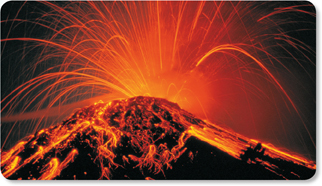19.3 Earth's Early History
 What do scientists hypothesize about early Earth and the origin of life?
What do scientists hypothesize about early Earth and the origin of life? What theory explains the origin of eukaryotic cells?
What theory explains the origin of eukaryotic cells? What is the evolutionary significance of sexual reproduction?
What is the evolutionary significance of sexual reproduction?
endosymbiotic theory
Flowchart Construct a flowchart that shows what scientists hypothesize are the major steps from the origin of Earth to the appearance of eukaryotic cells.
THINK ABOUT IT How did life on Earth begin? What were the earliest forms of life? How did life and the biosphere interact? Origin-of-life research is a dynamic field. But even though some current hypotheses likely will change, our understanding of other aspects of the story is growing.
The Mysteries of Life's Origins
 What do scientists hypothesize about early Earth and the origin of life?
What do scientists hypothesize about early Earth and the origin of life?
Geological and astronomical evidence suggests that Earth formed as pieces of cosmic debris collided with one another. While the planet was young, it was struck by one or more huge objects, and the entire globe melted. For millions of years, violent volcanic activity shook Earth's crust. Comets and asteroids bombarded its surface. About 4.2 billion years ago, Earth cooled enough to allow solid rocks to form and water to condense and fall as rain. Earth's surface became stable enough for permanent oceans to form.
This infant planet was very different from Earth today.  Earth's early atmosphere contained little or no oxygen. It was principally composed of carbon dioxide, water vapor, and nitrogen, with lesser amounts of carbon monoxide, hydrogen sulfide, and hydrogen cyanide. If you had been there, a few deep breaths would have killed you! Because of the gases in the atmosphere, the sky was probably pinkish-orange. And because the oceans contained lots of dissolved iron, they were probably brown. This was the Earth on which life began.
Earth's early atmosphere contained little or no oxygen. It was principally composed of carbon dioxide, water vapor, and nitrogen, with lesser amounts of carbon monoxide, hydrogen sulfide, and hydrogen cyanide. If you had been there, a few deep breaths would have killed you! Because of the gases in the atmosphere, the sky was probably pinkish-orange. And because the oceans contained lots of dissolved iron, they were probably brown. This was the Earth on which life began.

FIGURE 19–14 Early Earth Violent volcanic eruptions helped shape Earth's early history.

Table of Contents
- Formulas and Equations
- Applying Formulas and Equations
- Mean, Median, and Mode
- Estimation
- Using Measurements in Calculations
- Effects of Measurement Errors
- Accuracy
- Precision
- Comparing Accuracy and Precision
- Significant Figures
- Calculating With Significant Figures
- Scientific Notation
- Calculating With Scientific Notation
- Dimensional Analysis
- Applying Dimensional Analysis




